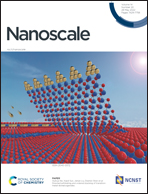MBE-grown ultrathin PtTe2 films and their layer-dependent electronic structures†
Abstract
2D platinum ditelluride (PtTe2) has received significant attention for 2D photodetector applications due to its novel physical properties. One of the critical factors that affect device performance is the film quality. Here, using molecular beam epitaxy, we investigate the role of growth temperature in determining the film quality of PtTe2 on highly oriented pyrolytic graphite, and unveil its layer-dependent electronic properties by X-ray photoelectron spectroscopy, Raman spectroscopy, and scanning tunneling microscopy/spectroscopy (STM/STS), as well as density functional theory (DFT) calculations. At low growth temperature (≤250 °C), the PtTe2 film prefers a stack of the monolayer and bilayer, while at ≈300 °C large-area continuous bilayer films are formed. In contrast, high growth temperature (>300 °C) leads to the formation of thick films with high Te deficiency and poor crystallinity. Theoretical calculations confirm the higher thermal stability of bilayer PtTe2 over other layer numbers above a critical crystal size of ≈100 nm2. STS shows that PtTe2 is a semiconductor in the monolayer with a bandgap of 0.80 ± 0.05 eV, and changes to a semimetal from the bilayer. DFT calculations support our experimental results and suggest an indirect bandgap structure of the monolayer. This work provides a systematic study of the layer-dependent electronic structure of 2D PtTe2, and demonstrates that with appropriate substrate and growth temperature choices, high-quality ultrathin PtTe2 films can be obtained, important for device applications.



 Please wait while we load your content...
Please wait while we load your content...